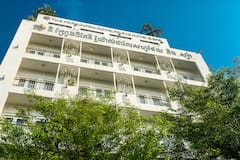Choeung Ek is a small village on the outskirts of Phnom Penh. A sleepy place today, very little belies the horrors that took place here in the not-so-distant past. That is, until you visit the Choeung Ek Genocidal Centre.
One of the brutal extermination centres and mass graves of the many souls who lost their lives during the vicious Khmer Rouge regime, it is Cambodia’s most-visited mass grave. The sites are collectively referred to as the Killing Fields, largely as a result of an emotive film of the same name, released to show the world the atrocities that the country suffered. The site at Choeung Ek is commonly referred to as the Killing Fields of Choeung Ek.
An important place for anyone who wants to understand more about Cambodia’s troubled past, it also serves as an important reminder to mankind about the shocking brutalities of war, both international and civil, and harsh dictatorial regimes. A visit will not be pleasant. Yet, it is one of those places around the world that should be visited, both to honour the victims and for a vital lesson in humanity.
As you learn more about the massacres at the Killing Fields of Choeung Ek, remember that this is just one place where these events took place. The scale of torture and death is unfathomable to most people.
Choeung Ek in context: A little bit of history

Between the years of 1975 and 1979, Cambodia was subjected to one of the most cruel and vicious political regimes known to man. Known as the Khmer Rouge period, ordinary people were dehumanised, tortured, and killed under the rule of one of the planet’s most infamous dictators – Pol Pot. Four years might not seem like such a long time. Not until you consider that during those four years, an estimated 2 million people lost their lives. Some reports suggest an even higher number.
Men, women, and children, rich and poor, people from all walks of life – dead. Deaths arose from starvation. People died from disease, and sickness – many of which could have been treated if only medical supplies were available. Forced labour killed some people. And then there were deaths resulting from torture and exterminations.
Cambodia (known then as Democratic Kampuchea) was a country gripped in fear. This was the time of the Cambodian genocides, sometimes referred to as the Cambodian Holocaust. Around one-quarter of the population died.
The communist Khmer Rouge had been operating in rural parts of the country before finally taking control, being stopped finally in 1979 by Vietnamese interventions. Whilst organised killings stopped, huge numbers of people continued to starve to death. The Khmer Rouge, as a political party, only officially surrendered completely in 1999. Almost every Cambodian today has memories of this period, lost family during the regime, or knows of relatives who perished before they were even born. Almost every family has a story to tell.
The fields of Choeung Ek were some of the places where the Khmer Rouge carried out mass executions. It is estimated that around one million Cambodians were executed during the reign of terror, with several thousand people meeting a brutal end at Choeung Ek.
Choeung Ek memorial

A large, yet simple, memorial stands at the front of the site, fairly unassuming when seen from a distance. The white stupa has large glass windows and is topped with glittering silver and gold. A symbol of the atrocities and a way to remember the victims, the hard-hitting part is contained inside the stupa.
Rather like something you would expect to see in a horror film than be confronted with in real life, the stupa contains thousands of bones. Bones carefully and tastefully arranged into displays, but, nonetheless, bone. Bones from real people. People that were once like you. Living. Breathing. Walking. Talking. All people who were killed at the hands of the Khmer Rouge.
There are thousands of ghastly skulls, separated into sections for males, females, and children. The skulls are positioned to look out over the surrounding area, their sunken eye sockets now void, their eyes no longer watching horrific acts unfold.
There are also displays of all kinds of bones, including femurs, tibias, radii, ulnas, and ribs.
Mass graves on stark and barren land

There isn’t really so much to actually see at Choeung Ek Killing Fields. The mostly bare land in itself adds to the austere atmosphere. Wander around the site whilst listening to the informative and moving audio guide (provided at the entrance, included in the admission fee, and available in several languages) and you will shudder at the now peaceful area’s past.
There are signs in some areas indicating how many bodies were found buried in the different mass graves. The largest mass grave uncovered, to date, contained more than 400 bodies. You will also recoil at the grave site where none of the recovered corpses had heads. Some areas are yet to be excavated – please respect the boundaries of any parts that have been roped or fenced off.
Particularly jarring, you may spot torn remnants of clothing and fragments of bone as you walk around, particularly if it has been raining.
You might be interested in these Airbnbs!
Display of ragged textiles

A glass display case contains dirty and torn pieces of textiles in a variety of colours. These torn and ripped pieces of cloth are the remains of clothing worn by those slaughtered at the Killing Fields of Choeung Ek. You can make out the coarse material and common patterns that are still worn by many people around Cambodia today.
Some pieces of clothing have been found scattered around the site, having made their way to the surface after heavy rains have disturbed the soil. Other pieces have been uncovered during excavations.
Well-marked areas that were of particular significance

Signs in English mark spots that were once important for the notorious killers, often providing details as to how and why certain things were done. You can see where the chemical storage room once stood, and recoil when you read what the strong chemicals were used for.
One tree was used to barbarically kill babies, their small skulls bashed against the sturdy trunk to render them lifeless, their desperate cries silenced.
Another tree is referred to as the “Singing Tree”. Imagine the scene - a radio hanging from the tree, blasting popular music, to mask the screams from those being killed. There was certainly no singing from the souls taken out to Choeung Ek.
It is hard to completely grasp the atrocities, and you may feel almost numb as you discover more.
Practical information for visiting the Killing Fields of Choeung Ek
Choeung Ek is located around 15 kilometres (9.3 miles) outside of Phnom Penh. One of the easiest ways to visit the site is as part of an organised tour. Tours can be booked from numerous hotels, guest houses, and travel agencies around Phnom Penh. Tours may include other places of interest too, such as the infamous S.21 Tuol Sleng, a former prison and torture centre. Prices vary, but, as a rough guide, you should expect to pay around 200,000 KHR (approximately 49 USD) for a half-day trip to the Killing Fields of Choeung Ek and S.21 Toel Sleng, including transportation and admission fees.
You can charter a tuk tuk (three-wheeled motorised vehicle) to take you to the Killing Fields of Choeung Ek. The price will largely depend on your negotiating skills. Expect to pay around 42,000 KHR (approximately 10 USD) for a return journey to the Killing Fields of Choeung Ek. You would then need to pay the entrance fee of 25,000 KHR (approximately 6 USD).
Arrange your sombre visit to the Killing Fields of Choeung Ek to learn more about Cambodia’s devastating history.
History
Get Trip101 in your inbox
Unsubscribe in one click. See our Privacy Policy for more information on how we use your data




















Create an account to